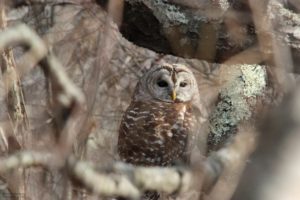by Jane Kolias
Last week Becky Suomala received a phone call that an injured Barred Owl was on a busy roadside in the town of Concord. Overhearing the call, I offered to drive Becky and volunteer Stephanie Parkinson to the area to check out the situation. The caller, Stephanie’s husband Bill, described where the bird was and as we neared the location we saw a brown lump ahead on the side of the road. We could not readily tell if it was the owl or a lump of snow but as we crept by as slowly as the traffic stream would allow we saw that it was an owl but it was not moving.

After pulling safely off the road Becky and Stephanie took the carrying case (which I always have in my car) and walked back towards the owl, which was indeed alive and obviously injured. Once the owl was in the carrier and in the car we covered the carrier with a blanket to minimize stress to the bird. After a quick stop at the McLane Center I headed directly to Wings of the Dawn, a wildlife rehabilitation center run by Maria Colby in Henniker.
I arrived with the owl still alive and Maria expertly extracted it from the carrier, made a quick assessment and administered some medication. She then placed it in a warm and secluded enclosure to rest and (hopefully) recover. I asked Maria if she has been seeing a lot of owls in her rehab and she said I was the SIXTH owl that day, and the previous day she had FIVE brought in…all Barred Owls.
I later did a little internet search of other wildlife rehab facilities in New England to investigate their experience this year with injured Barred Owls. The Center for Wildlife in York Maine reports they had 12 Barred Owls come in over a six week period which is usually the number of owls they see over an entire winter. The New England Wildlife Center in Weymouth Mass reports seeing 3 or 4 times as many Barred Owls coming into their facility this winter in comparison to previous winters.
So why are wildlife rehabs seeing so many more Barred Owls this winter? According to an article from The Connecticut Audubon Society, wildlife biologist Scott Williams has been doing small mammal studies and his theory is that mice populations have plummeted this year following two banner years in 2016-2017. You can read the article and see a mice population graph on their website.
More About Barred Owls
by Becky Suomala
Barred Owls are particularly plentiful this winter and many people have been reporting them both day and night. In the fall of 2017 there was a large “mast” crop – seeds, cones and berries. Small rodents had plenty of food to survive the winter and raise young in the spring of 2018. This resulted in plenty of small rodents to provide food for large broods of young owls. The mast crop in the fall of 2018 was poor so all these owls are searching for food wherever they can.
Barred Owls feed primarily on small rodents such as mice and voles, but are known to take other small mammals such as squirrels and even frogs and fish! The owl will sometimes hunt in daylight, especially in winter when there’s snow-cover making it hard for them to find prey. They sometimes sit on or near bird feeders looking for small mice and other mammals that come to feed on the seed that has fallen on the ground. Hungry owls may also hunt along roadsides more than usual and have a higher risk of being hit by cars.
